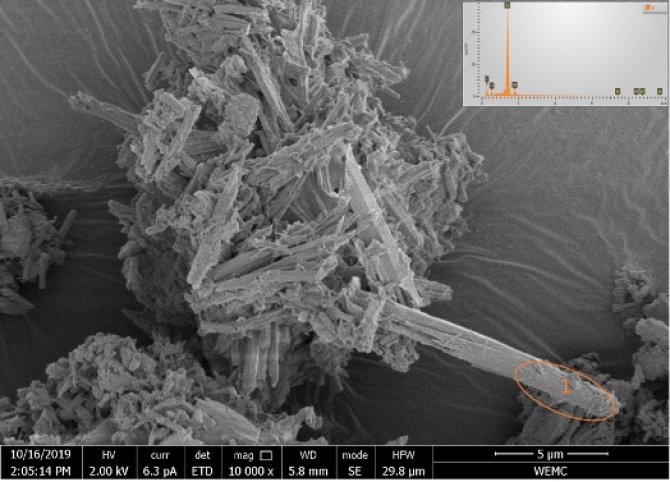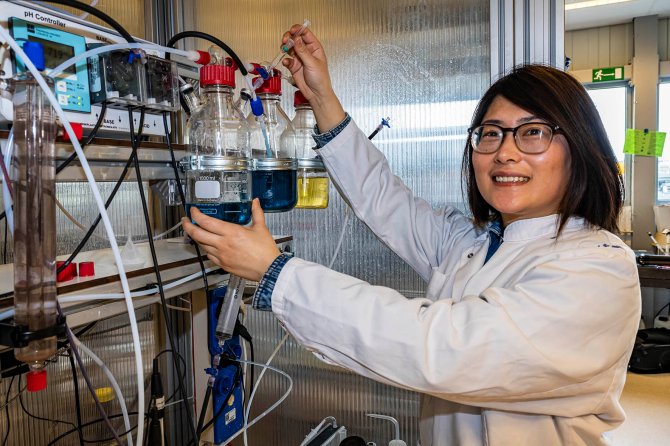
News
Science: A new bio-recovery method for efficient selenium retrieval from wastewater
PhD researcher Bingnan Song developed an improved biological method to remove and recover selenium from wastewater. Specialized bacteria converted more than 95 % of the selenate present into elemental selenium. In addition to this high efficiency, conversion rates were about 6 times higher than in traditional methods. Increased pH resulted in improved selenium crystal formation enabling an easier recovery and reuse.
Selenate, (SeO42-), is common in wastewater from many different industries, for example, in waste streams from copper mining and the subsequent refining process. In small quantities, selenium is an essential micronutrient for animals and humans, but at higher levels it is toxic and bioaccumulates in tissues. Improper disposal may also result in accumulation in the environment, resulting in toxic effects in aquatic wildlife. Therefore, the selenate present in wastewater has to be removed. A variety of methods can be used to achieve this, like precipitation by adding chemicals or removal using membranes. However, these methods are costly and require chemicals or tedious membrane cleaning procedures. Selenium retrieval using bacteria could be a better solution. Currently, some cleaning and recovery methods utilize bacteria that convert the selenate present into elemental selenium under anaerobic reactor conditions.
Recycling problems
But these biological treatment methods have some serious limitations. Most of the selenate present is converted into an intermediate product, selenite (SeO32−). This substance stays in the solution and can therefore not be removed.
In addition, the bacterial conversion rate from selenate into to elemental selenium is rather low: it is only about 1% of the biological sulfate removal rate from wastewater, a commonly used cleaning technology. ‘Clearly, biological selenium recovery is still in its infancy’, Song explains. ‘Besides being a very slow conversion rate, these methods result in the formation of small, amorphous selenium particles about only 250 nanometers in size, i.e. 500 times smaller than the thickness of a human hair.’ These tiny selenium particles are mixed with bacterial biomass, making it hard to separate and recover for reuse. Storage of this selenium-containing waste is no great option either, since it may pose environmental hazards due to the possibility of selenium leakage. Therefore, a more efficient and fast method to clean selenium-containing wastewater while recovering and recycling this resource is desperately needed.
Crystal formation
Song aimed for a better biological recovery method, that included a fast and highly selective conversion of selenate into elemental selenium, resulting in a high-purity and reusable end product. In addition, the conversion should result in a solid selenium product that was easily separated from the aqueous phase in the reactor. To meet this condition, the scientist targeted the formation of selenium crystals. As a first step, Song used bacteria-loaded sludge from the wastewater treatment site at Eerbeek. This sludge contains many bacteria species, especially those converting sulfate (SO42-). By using a so-called ‘sequencing batch reactor’ she fed the reactor with an influent containing plenty of selenate. This way, she created a reactor environment favoring and selecting the bacteria that were converting selenate into elemental selenium. During the selection process, the suitable bacteria able to transform selenate into elemental selenium tend to settle at the bottom of the reactor, together with the selenium formed. The others stayed in the solution and could easily be flushed out. Song: ‘This way, we selected the right bacteria for the selenium conversion step by step.’ In addition, the scientists increased the pH from 7.0 to 7.5, enhancing crystal formation.

Large crystal clusters
Song’s research eventually resulted in an efficient selection of selenium-converting bacteria, that were no less than 1000 times faster in forming elemental selenium than the bacteria present in the originalsludge sample. Compared to the traditional biological selenium recovery methods, the new bacteria performed much better with conversion rates over 6 times faster, while removing more than 95 % of all selenate present. Another important result was that the selenium was effectively formed as relatively large crystal clusters, the biggest ones measuring 200 micrometers in size, almost 1000 times bigger than the amorphous particles formed in the traditional methods.

The newly developed process may serve as an alternative efficient, quick and effective method to remove and recover selenium from wastewater with high selectivity. Due to the formation of large crystal clusters, recovery and reuse are relatively easy.
Reference
Song, B., Tian, Z., van der Weijden R.D., Buisman C.J.N., and Weijma J. 2021. High-rate biological selenate reduction in a sequencing batch reactor for recovery of hexagonal selenium. Water Research 193, 116855